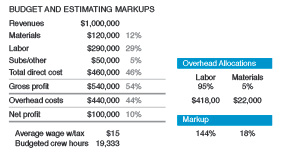We live in deflationary times. Simply put, there’s less money chasing many goods and services. It’s the opposite of inflation, to which we’re more accustomed. What this means for you is that raising prices is a sure way to reduce revenue — and not having a plan to save the customer money will render you uncompetitive much of the time.
There are three ways to manage your pricing:
- Re-engineer the job.
- Reduce overhead.
- Reduce profit margins.
With each option, there are trade-offs, as well as the certainty that no matter which one(s) you choose, you’ll have to work harder than ever to convince the customer you’re the best fit for the job while still making a profit.

Let’s take these different approaches individually by addressing just the impact of job re-engineering. Starting from a budget, we determine two key estimating factors: material and labor markups on cost. The table aside shows this calculation.
The markups are established by determining how the $440,000 overhead will be recovered. In this case, 95% of overhead is allocated and recovered by labor, 5% by materials. This results in a 144% markup on labor cost ($15/hour) and an 18% markup on material cost. In every case, we’d bid a job with these markups and a 10% profit margin given our budget.
Compare that with the impact of re-engineering job costs. Re-engineering can be accomplished through better design, smarter material purchasing and production efficiencies that result from the first two.
Let’s say the original job price per plan produces a price of $12,082 based on 200 production hours and $3,000 in material cost. But through a review of the site, we recommend a slightly different and better design in the proposal. A relatively small reduction of labor hours and material cost — through plant substitution and leaning on the nursery for pricing (remember, it’s a deflationary economy), combined with a tighter production schedule that trims 20 production hours — results in a price of $10,611.
That’s a 14% reduction, which is a step in the direction of better marketing and sales. The way to manage price, as any marketer knows, is to address product costs. And as most marketers and salespeople know, it’s their job to convince customers their products are right for them — without trimming profit margins.
The great thing about the re-engineering option is you don’t have to reduce your margins. The challenge is you have to be on your game and convince the customer your plan is the right way to go.

